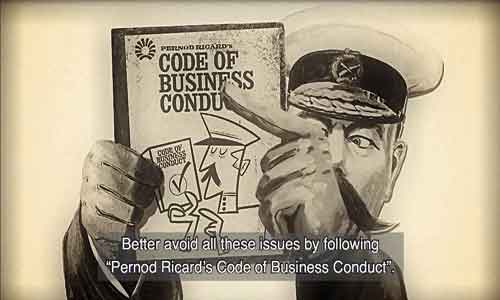
The compliance stakes are climbing higher and higher for global companies. Over the past few years, French companies in particular have had a wake-up call: three of the ten biggest-ever FCPA fines have been levied on businesses headquartered in the country.
The fine of almost $9bn imposed on BNP Paribas for sanctions-busting in 2014 took up much headline space in France, and made many a corporate leader pause to consider the ramifications of glossing over compliance.
Fortunately for Ian FitzSimons, the Paris-based GC of Pernod Ricard, his company is taking compliance – and the education of employees – very seriously indeed. ‘Being a company that has grown relatively quickly over the last ten years we are playing catch-up to some extent, but the benefit is we can pick the best elements currently available and make full use of them,’ he says.
Ian FitzSimons’ top tips for developing an online training programme:
- Be creative and concentrate on ways to interest and engage the audience.
- Be concise and focused about what you are delivering.
- Use outside consultants and take advice from HR and other training professionals.
- Ensure the programme is well-designed and looks appealing.
- Don’t expect the online training to do it all; you will need to follow up with bespoke training where needed.
Creative delivery
The proliferation of theory around digital and online delivery of education has fundamentally influenced the online training portal that Pernod has developed. ‘If you go back ten or twenty years as an in-house lawyer and think about training, the answer was generally, “well, we will go round various business units and give a 45-minute PowerPoint presentation with slides and take questions”,’ FitzSimons explains. The problem with trying to roll out such a programme effectively in today’s multinational is obvious, and is exacerbated by the additional challenge of making the training interesting and therefore impactful. Says FitzSimons: ‘We wanted, basically, all 18,000 of our employees to be properly educated – so we had to be a bit more creative than a PowerPoint!’
Luckily, the team had a head start. Pernod Ricard has its own university – a company-wide global training function for all aspects of staff development. The enterprise is managed by the HR department, with whom the legal team works closely, and includes education professionals who are able to advise on the best modes of delivery. What was decided upon was a ‘MOOC’ (Massive Open Online Course) – now one of the buzzwords in educational theory. The MOOC contains elements of ‘gamification’ (the use of game thinking and design outside of the game context), which has been shown to promote much higher levels of engagement and consolidation of learning among participants.
The Pernod Ricard University put the legal team in touch with an outside agency, which was instrumental in driving forward the design and user interface of the new online portal. ‘The whole look and feel is innovative and new for us,’ says FitzSimons. ‘It has various training modules and the user can dip in and dip out. There is an element of gaming, as you go into the different modules with three lives. You can also enter into contests with different colleagues, get medals for interactions with coaches, watching all of the videos and so forth.’ The online training modules are supported by original video content written by the legal team – and in many cases delivered by them too.
Video star
The first video introduces the company’s code of conduct. Humorous and engaging, it’s definitely not a chore to watch, thanks to the highly original and creative delivery of its message. FitzSimons explains the genesis of the idea: ‘I was thinking about the marketplace, and then thought of Flemish market scenes, and a Bruegel-type scene. We put this to the marketing department, which put us in touch with a Belgium-based animator. We got the rights to adapt the paintings, which were turned into animations (see picture above). We came up with the ideas in legal, bounced these around with the animator, and wrote the script. Then we got professional actors to do the voice overs.’
The video animates characters within the Bruegel-style marketplace who display classic market abuses such as bribery or price fixing. They are then chastised by other recognisable ‘characters’ from artwork, such as the iconic First World War image of Lord Kitchener (see picture above), or the central figure of Edvard Munch’s The Scream. It brings the company’s code of conduct to life in an amusing way that really gets the point across. ‘The video was mostly designed for people whose main role will be in the promotion and sales of our products, so we had to effectively sell it to the viewers and get them intrigued – it could not be boring,’ FitzSimons says.
Other videos were developed by, and even star (!) the in-house lawyers. But the messages are delivered in a very concise way. FitzSimons explains that, ‘traditionally, if a lawyer is asked to give an introduction to competition law they might think of speaking for 40 minutes. We were told we had to do it in two minutes!’ This takes account of the short attention span of non-experts. But, he adds, ‘it’s an incredibly useful discipline. It’s something in-house lawyers need to do anyway, as one of the key factors for success in the business is being able to take complex issues and distill them down.’
These videos are accessible and are presented in a friendly and personable manner by members of the legal team. According to FitzSimons, ‘the videos make the lawyers come across as quite approachable people. The tone and feel of the videos are quite open and receptive. People will think: “I have a question; that is someone I can talk to.”’
FitzSimons wanted the videos to be fronted by people who have an affinity with the topic being discussed. For example, the competition video is presented by Ingrid Cope, who was formerly with the Office of Fair Trading (OFT). For FitzSimons, it’s a good opportunity to give team members other than himself visibility across the entire company.
A diagnostic tool
The online portal is not intended to be a panacea. ‘What we are looking to achieve is to educate people on the fundamentals,’ says FitzSimons. ‘Employees can do the whole thing in two or three hours, but can break it up into smaller chunks.’
The portal also allows the legal team to make sure that people have done it. If a participant gets too many questions wrong they have to repeat it – and different questions may come up. Part of the function of the MOOC is diagnostic as well, as FitzSimons explains: ‘If people say, “I have done the antitrust training model, and I eventually got through it, but part of it caused me a problem in relation to our specific business here,” [the legal team knows] via the training module who they can raise this with, and it might lead to culturally-specific, tailored education.’
Interestingly, the training module that FitzSimons demonstrates begins with questions, and not the usual information piece beforehand. This is not a technical fault, he insists, but part of the educational design. ‘I was a little confused by that myself, thinking you get the lecture then the questions. But it’s apparently better to learn by asking questions, then you get clues, then you can go back to the questions again. Essentially you can learn better by failing than learning by rote.’ Better to have failure happen in the MOOC than in the real world, of course!
The legal team at Pernod Ricard is thankful to be part of a company that takes education, in all its forms, seriously – and is willing to spend a lot of money on it. Another positive is that the nature of the company’s products and latitude to market those products creatively have, in turn, allowed the legal team to be innovative in the way it ‘markets’ compliance training. FitzSimons sums it up thus: ‘We are given a reasonable amount of autonomy; they allow us to try things that are different and creative.’
But he thinks the take-away point from his team’s experience is that anyone can do this and can tailor it for their own business environment and culture. He also believes that lawyers are fundamental to a company’s training, because they themselves have been schooled in how to present properly to the business. And despite the novel conceptualisation, simplicity is key. Says FitzSimons: ‘Focusing on getting two or three key points across in an interesting manner is essentially what the exercise is about.’


